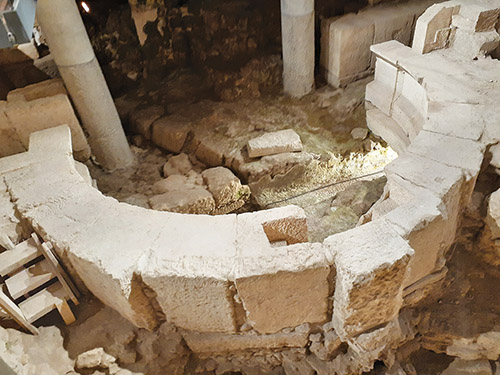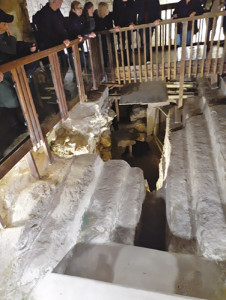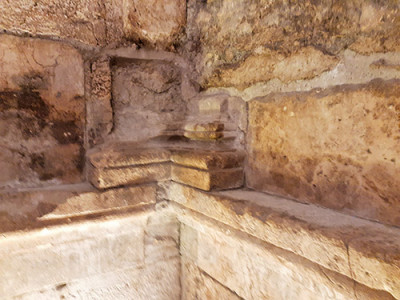
As of one year ago, a new tour has become available through the Western Wall Heritage Foundation, which has been touring the Western Wall tunnels since the late 1990s. Joining The Journey to Jerusalem, A Look Into the Past, The Chain of Generations Center and The Great Stone Route is The Great Bridge Route tour.” The tour takes its name from the bridge that connected Jerusalem’s Upper City with the Temple Mount. It was designed approximately 2,000 years ago to traverse a valley, thus eliminating a climb up and down again. The bridge also included an aqueduct that brought water to the Temple area.
Our tour, led by an American olah, began at the same entrance as the classic tunnel tour, but shortly veered off to the left and descended a level deeper. Before descending further, we were shown a PowerPoint presentation of the bridge in relation to the Kotel and a square structure that would be significant later on in the tour.
At the bottom of the descent, we saw the massive stones and arches that supported the bridge. But we also saw a layer of smaller stones held together by what was referred to as “Roman cement.” These secure smaller stones, almost likened to river rocks, held the base of the bridge, and are still holding strong thousands of years later.

We were then led into the aforementioned big, square space which has become known as a “very exclusive building,” according to archeologists. It was constructed of decorative columns as well as an elaborate water system. The area also includes three mikvaot. The supposition is that Herod built this room as an exclusive supper club for his VIP friends, who would relax and dine there after which they would immerse in the mikvaot and proceed to the Temple.
As we proceeded, we entered an area directly under Wilson’s Arch or the point at which the bridge entered the Temple Mount. Facing us was a wall that has been discovered only within the last 10 years, and obviously so. Whereas the Kotel stones are markedly worn and weathered, these stones were smooth and shiny as they had been protected from the weather and looked as they had 2,000 years ago. According to our guide, “They are stunning.”
We then turned around from this new wall and saw what looked like an amphitheater, but not complete. It resembled a typical Roman amphitheater; the theory is that before its completion, the Bar Kochba Revolt had begun, which distracted the Romans who were never able to complete it.
At one point in the tour, we gathered within a large excavation and took seats on a low wall where we were shown a 3D model of the tunnels we had been touring. The technology raised and lowered the levels of the excavations to show us the progress being made with each new discovery. Seeing state-of-the-art technology used to uncover the mysteries of the ancient world was astonishing.

Our final stop, and my favorite, was a stunning sanctuary, whose walls are ancient stones and yet whose pews are made of modern mahogany wood in elegant design, and with a shiny floor of alabaster. The Aron Kodesh, a pomegranate-shaped golden sphere elaborately engraved with the words of “Shir haShirim” is a sight to behold. Under construction for 12 years, the shul, which includes a roomy women’s section, is opened to the public at set times for celebrations and milestone occasions. Imagine being able to celebrate a family simcha in the 21st century within the ancient walls of our Holy Beit Hamikdash! What an honor and a zechut!
For information and reservations for the Western Wall Tunnel Tours call 972-2-627-1333 or visit www.thekotel.org or contact_english@thekotel.org
By Pearl Markovitz









